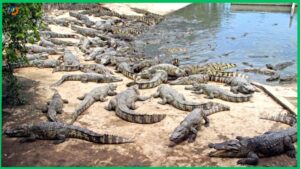This article explores the process of raising crocodiles from eggs to processing , with a focus on harvesting their meat and skin. Discover how professional processing facilities transform these raw materials into high-value products.
Crocodile Farming in China: Large-Scale and Unique Processing Facilities
Egg Incubation in Processing Plants
Crocodile farms in China invest in modern, professional incubation systems that ensure optimal temperature and humidity levels. Crocodile eggs are treated as treasures, carefully handled before being placed in specialized incubation processes. Within 65–90 days, millions of hatchlings emerge, ready to begin their growth journey.
Crocodile Rearing Environments
Farms utilize advanced tank systems to provide optimal animal welfare and growth conditions. Water in the tanks is filtered and replaced daily, preventing diseases and ensuring the crocodiles are of high quality when transferred to processing factory.
Scale and Professionalism in Processing Environments
Chinese crocodile farms operate as closed-loop systems, leveraging automation technology. This not only boosts productivity but also reduces operational costs, facilitating the swift transfer of mature crocodiles to processing factory.
Harvesting and Transfer from Farms to Processing Factory

Harvesting Procedures
Fully grown crocodiles are meticulously selected. Advanced technology enables efficient harvesting, after which they are transported to processing facilities.
Role of Processing factory
Experts at the plants perform precise skinning and meat processing operations. Crocodile skins are carefully preserved, while the meat is portioned and packaged to meet various demands. Cold storage and automated packaging systems ensure product quality during storage and transportation.
Processing Crocodile Meat in Modern Plants
Detailed Processing Procedures
Crocodile meat is divided into sections such as tail, back, and legs, all meeting stringent quality standards. In processing factory, tasks like skinning, cleaning, and cutting are conducted with advanced machinery, minimizing manual intervention.
Final Products
Crocodile meat is meticulously processed and packaged. Some portions are prepared as ready-to-eat products or exported to foreign markets. These products cater to culinary, pharmaceutical, and cosmetic industries, reflecting the crucial role of processing factory in the value chain.
Concerns Over Excessive Crocodile Exploitation

Conservation Challenges
Excessive harvesting of crocodile skins for luxury fashion has raised concerns about species conservation. Animal protection organizations advocate for more sustainable farm management and processing practices. The Chinese government has implemented strict regulations requiring farms to obtain permits and comply with animal welfare guidelines.
Towards Sustainable Development
Many modern plants have adopted eco-friendly processes, minimizing resource wastage and optimizing the use of crocodile by-products. Wastewater treatment and renewable energy systems at these plants reduce environmental impact.
Automation in Processing Factory

Advanced Technologies
Modern processing plants employ automation to enhance efficiency and reduce errors. Automated systems streamline processes such as material intake, skinning, meat processing, and packaging, saving time and costs. This technology boosts productivity while meeting food safety standards.
International Food Safety Standards
Crocodile meat processed in these facilities adheres to global hygiene and quality standards. Steps like cleaning, thermal processing, and packaging undergo rigorous inspections, ensuring export-quality products.
Export Potential of Crocodile Products

Expanding International Markets
Crocodile meat and skin products are increasingly popular in demanding markets like Europe, the U.S., and Japan. Chinese processing factory have successfully built brands and developed export-ready products, delivering outstanding economic value.
Diverse Products and Added Value
Besides meat and skin, by-products like bones and oils are utilized in cosmetics and pharmaceuticals. This approach not only increases value but also reduces waste, contributing to a sustainable circular economy model.
Lessons from China’s Crocodile Industry

Technology Integration
Other countries can learn from China’s use of advanced technologies in farm and plant management. Automated systems and real-time quality monitoring significantly improve productivity and product quality.
Conservation Awareness
While developing the crocodile industry, China also emphasizes conservation measures. Adopting similar management models can help ensure sustainable practices and protect natural resources.
Advanced Technology in Crocodile Processing
AI and IoT Applications
In the digital age, Chinese crocodile plants actively incorporate Artificial Intelligence (AI) and the Internet of Things (IoT) to optimize production. AI monitors the entire processing line, from quality control to inventory management. IoT ensures optimal storage conditions by tracking temperature and humidity levels.
ERP System Integration
Many processing factory use Enterprise Resource Planning (ERP) systems to manage raw materials and finished products comprehensively. This streamlines operations and provides real-time reports for accurate business decision-making.
Success Stories in Crocodile Processing
Anhui Crocodile Processing factory: A Model Example
The Anhui processing plant is one of China’s most advanced facilities. Its large scale and cutting-edge technology serve both domestic and international markets, exporting to over 20 countries. This success demonstrates the value of investing in technology and skilled labor.
Conclusion: A Comprehensive Industry
The crocodile industry, with its focus on processing factory, not only generates economic value but also contributes to resource conservation and cultural preservation. From farms to modern production lines, each link plays a vital role in a sustainable value chain.